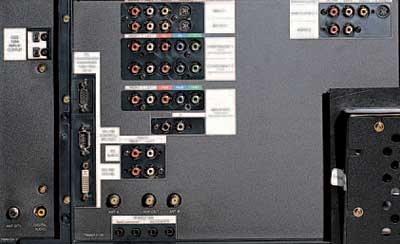Mitsubishi WL-82913 82-inch LCoS Rear-Projection HDTV Page 2
| HIGH POINTS Extremely detailed images. Great color reproduction. Wide range of connection options. LOW POINTS Expensive. Limited shadow detail. |
All of a TV's features matter little, however, if the picture isn't up to snuff. After a brief calibration (see "in the lab" at the end of the of this article), I spun up the Steven Soderbergh version of Solaris. The intricate detail, rich color, and sheer size of the image kept me riveted on this slow-moving, psychologically deep film from the opening titles until the credits at the end. As George Clooney's ship approaches the space station, the vast indigo planet below seethes with amorphous cloud shapes and wispy protrusions like solar flares. I took in every inch of the ship's complex fuel tank clusters, airlocks, and circular outriggers. The detail was crystal clear. 
Thanks to the set's exceptionally accurate color decoder, I was able to achieve a perfect color balance. The benefits of this were particularly visible in the haunting sequence that blends scenes of Clooney and his wife's first meeting and scenes of his first encounter with her alien doppelgänger. The blue of his cabin on the station looked icy, contrasting with the warm, glowing - but never too intense - reds of their apartment back on Earth. When her face finally materializes out of the shadows, the variations in her skin tone, red lips, and dark eyes combined for a look that was downright supernatural.
Her ghostly appearance also drew out the main weakness of the Mitsubishi: its inability to display deep blacks and fine shadow detail. The shadows at the edges of her face seemed to drop off into darkness instead of fading gradually, and the darkness itself was a shade of deep gray, not true black. (Mitsubishi says the software in the preproduction unit we reviewed has been updated with new gamma curves that allow it to do a better job with black level and shadow detail.)
I also noticed that the TV's 2:3 pulldown detection didn't seem to be functioning as well as that of my progressive-scan DVD player. When Clooney first arrives at the station, a pan from some space helmets across the airlock, and the lines on the bulkheads framing the windows, were interrupted by slight jagged edges. When I switched the player back to progressive mode, the jagged edges disappeared.
With a FireWire connection linking my D-VHS deck and the TV, a 720p-format high-definition montage from the new Digital Video Essentials test tape looked exceedingly crisp. The big-screen, high-resolution LCoS set clearly highlighted the difference between DVD and HDTV. Shots of Earth from the space shuttle were a feast of minutely detailed clouds, mountain ranges, and deep blue oceans, a refreshing change from the alien purple of Solaris. I saw tiny spots on the back of a brilliant yellow grasshopper and the separation between each panel of its abdomen. During one pan, however, the side of one of the skyscrapers flickered a bit, a scaling artifact visible as I watched both the 1080i and 720p versions of the tape.
The Mitsubishi conglomerate manufactures lots of stuff, but we Americans know the name best in terms of cars and TVs. Considering that the WL-82913 costs as much as a 2003 Galant V6, not too many people can afford to bask in its projected glory. If you're one of them - Orange County resident or otherwise - and you've decided against installing a dedicated front-projection system, the biggest RPTV on the planet may be just the alternative you're looking for.
In the Lab
Color temperature (Warm color temperature before/after calibration) Low window (30-IRE): 7,488/6,489 K High window (80-IRE): 7,497/6,493 K
Brightness (Warm color temperature before/ after calibration, 100-IRE) 28.8/26.2 ftL
Prior to calibration, the WL-82913's grayscale measured somewhat higher than the NTSC standard of 6,500 K, although it was very consistent from the low to the high end of the scale. Calibration resulted in a nearly perfect grayscale, varying by less than 50 K from 30 to 80 IRE - impressive. (Calibration needs to be performed by a qualified technician with specialized equipment, so discuss it with your dealer before purchase, or call the Imaging Science Foundation at 561-997-9073.)
After calibration, light output was close to ideal for an RPTV. The set's NTSC color decoder was refreshingly free of "red push," varying by no more than 5% according to the test pattern from the Avia DVD. After adjustment, the decoder was spot-on. DC restoration was excellent; the level of black varied only slightly with changes in the average brightness level. The TV would not display a 10-IRE window pattern from its 480p input, but it would via its 480i input. Convergence of the three LCoS panels wasn't perfect: I noticed red and green fringing around the white dots in a convergence test pattern. Geometry was perfect, and overscan patterns indicated no more than 4% picture loss on all sides, which is average. I noticed no screen-door effects, and individual pixels only became visible at less than 2 feet from the screen. Corner-to-corner focus was nearly perfect, with the set displaying excellent brightness uniformity over a wide viewing angle.













































